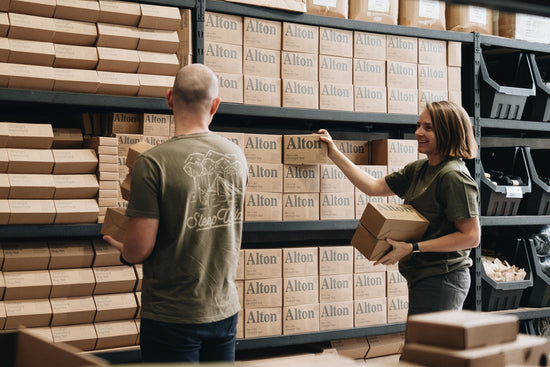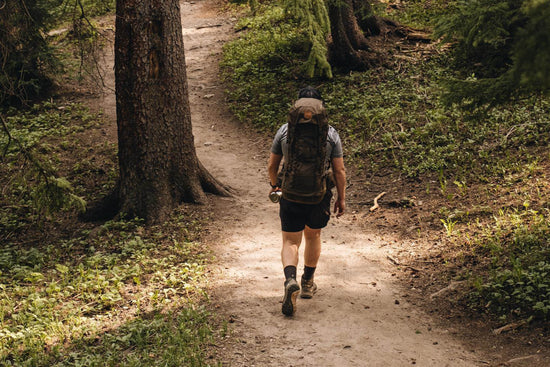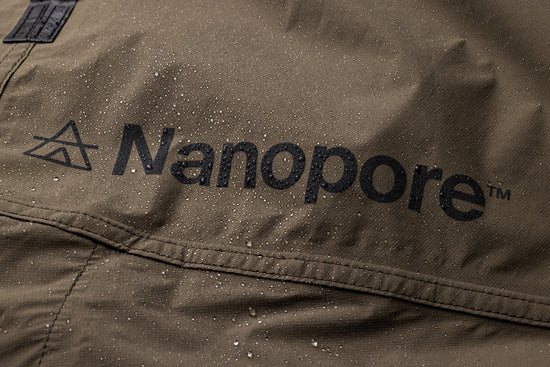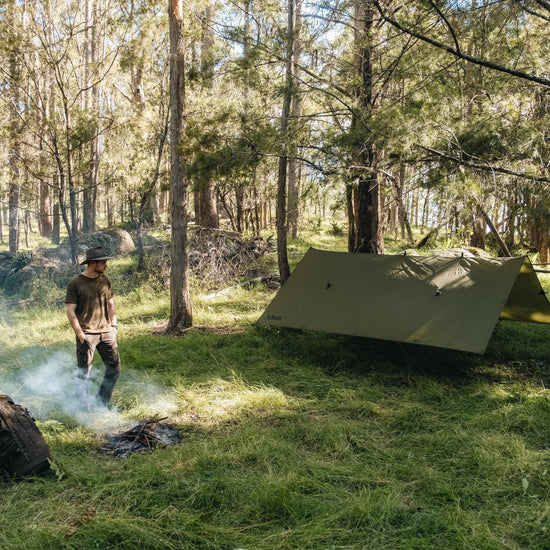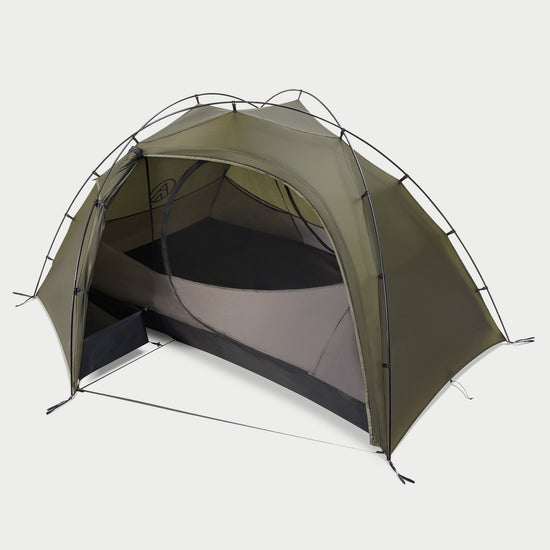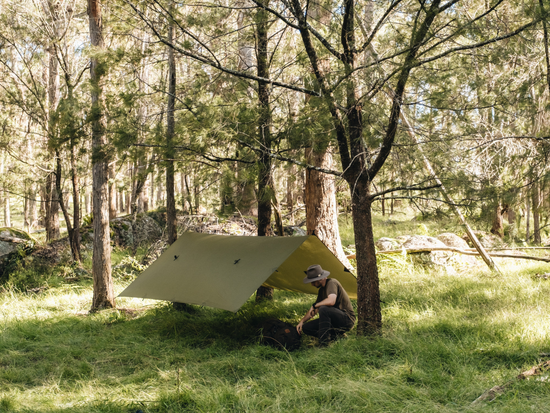Not sure whether to go with a tarp or tent for your next camping adventure? We've got you covered (pun intended). From the weight in your pack to the level of protection you'll need, we’ll compare how tarps and tents stack up and provide straightforward insights so you can make an informed choice.
But, here’s the thing: there is no ‘perfect’ shelter. The tarp vs tent debate is not about irrefutably proving that one shelter is universally better than the other. Instead, it is about asking what each shelter option brings to your specific camping experience. In this guide, we break down the pros and cons of camping tarps and tents to help you choose the right shelter for you.

Which tarp and tent are we comparing?
Tents and camping tarps come in a huge variety of models and designs, all with very different specs. There are tarp-tents and tent-tarps and everything in between. But, in this tarp vs tent debate, we’re keeping it simple.
What we’re classing as a ‘camping tarp’ is a single sheet of waterproof fabric with tie out points, such as our 3m x 3m Ultralight Tarp. For ‘camping tent’, we’re referring to a standard backpacking tent made up of a lightweight inner tent body and an outer rainfly, both of which are secured over a rigid frame made from metal poles. You get the idea!
Let the battle begin!

Best Shelter for Weight & Packability: Camping Tarp
Camping tarps have the advantage when it comes to weight and packability.
But not by as much as you might expect.
Used alone, a camping tarp is considerably lighter than a tent. However, you need to factor in any equipment you might be using with your camping tarp, such as a groundsheet, bug net and a hiking pole or two.
When we add all that up, a complete camping tarp shelter typically weighs between 500g and 1.5kg. In comparison, a standard one-person tent can weigh between 700g and 2.5kg, depending on the materials and built-in features.
Best Shelter for Durability: Tarps... but only just.
It's pretty tricky to say there is a definitive winner for this category. Both tents and tarps can offer great durability and last for years of solid use.
Tents feature a range of components: zippers, poles, footprint, inner mesh, rainfly, etc.. These all serve a purpose, but more components also means that there are more possibilities for things to go wrong.
On the other hand, tarps are extremely simple, which means that there are fewer ways for them to fail. They can also be made from stronger materials without adding much weight overall. That means that if you're comparing fabric alone, a tarps will come out on top – but only just.
If you invest in a good-quality tarp or tent, you can expect a decent level of durability from either, provided that you take care of it.
Best Shelter for Weather Protection: Tent
Camping tents are designed to provide a waterproof shelter that can be sealed off from the outside. Although you can configure your camping tarp to provide protection from rainy, windy and even snowy weather, they just don’t provide the same level of coverage (or comfort) in extreme conditions.
Best Shelter for Insect & Animal Protection: Tent
Tarps require additional accessories like bug net or a bivy sack to create a barrier against insects. These measures can also help to deter animals, but if you are camping in areas where insects or animals could be a safety risk, a tent might be the wiser choice. Tents keep insects and animals out because they offer 360º of protection, with no gaps or openings for unwanted guests to sneak through.
Best Shelter for Ventilation & Airflow: Tarp
A well ventilated shelter improves temperature regulation and reduces condensation, the layer of moisture that forms on the inner walls of any shelter in cold weather.
Tarps reign supreme when it comes to ventilation, especially in hot climates. It is easy to set up a tarp to maximise airflow, keeping you cooler throughout the night. Tents, on the other hand, can feel suffocating in hot weather, no matter how well ventilated they are.
Best Shelter for Condensation Management: we’re calling it a draw.
Unfortunately, no shelter is immune from condensation. Condensation management really comes down to the specific conditions and configuration of your shelter, tarp or a tent, so we’re calling this one a draw.
If you are able to secure your tarp up off the ground enough to allow for airflow this can prevent condensation.
But, in cold, rainy or snowy conditions, you may need to fix your tarp directly to the ground and enclose it around you in order to stay warm and dry. This reduces ventilation, causing condensation to form on the tarp walls.
Due to their enclosed design, tents are more prone to condensation. However, there are a couple factors that help mitigate this issue.
First, most tents have built-in vents that allow for airflow through the shelter even when you are completely bunkered down in bad weather.
Second, condensation may form on the inner surface of the rainfly, but the body of the tent should remain dry (just don’t bump it!).
Best Shelter for Versatility: Tarp
Tarps are hard to beat when it comes to versatility. Camping tarps gives you more flexibility in how you interact with – and adapt to – your surroundings.
A camping tarp can function as a windbreak, sunshade and groundsheet. It can be used over other shelters such as a hammock or a tent. We’ve even heard tales of people using a camping tarp as an emergency stretch!
With their set structure, tents just don't offer the same range of uses. They are designed for a specific purpose, providing shelter in the outdoors. Adaptability is not the priority. This isn’t necessarily a disadvantage, but if versatility is important to you, then a tarp is the way to go.

Best Shelter for Ease of Use: it’s a draw!
This is another big point of contention in the tarp vs tent debate. Ease of use is so subjective, so what you find easy might be a headache for someone else.
Camping tarps and tents both require some technical outdoor skills and knowledge to set up, but what you prefer will come down to personal preference.
A camping tarp requires a little more skill to use effectively as a shelter. As well as learning multiple configurations, you will need enough outdoor experience to select the best tarp setup for camping in various conditions. But, don’t let that put you off. With a bit of practice, a camping tarp can be faster and easier to set up compared to a tent.
Camping tents have a predefined structure, which can be an advantage for campers who prefer a straightforward setup process. Although you’ll still need some basic outdoor knowledge, tents don’t require as much consideration when it comes to site selection, weather conditions and shelter configuration.
Best Shelter for Privacy: Tent
Many campers use their shelter as a place to change clothes, attend to personal hygiene and relax. Unless you are camping deep in the backcountry, it is important to choose a shelter option that offers you enough privacy and personal space to feel comfortable.
We can’t deny that camping tarps are more open to the world. This can be a great thing, if you are lucky enough to be camping in remote locations. But, if you are camping around other people then you might find yourself feeling a little exposed.
If you are conscious of your privacy and personal space, a camping tent can provide you with a more comfortable and private shelter compared to a tarp. Tents can be completely sealed off from the outside world, giving you your own secluded space to retreat to.
Best Shelter for Value for Money: Tarp
Although prices vary widely, a tent will be more expensive than a tarp of equivalent quality. And, this makes sense – with complex designs and multiple components, tents require more resources and specialised craftsmanship to manufacture.
A high-quality waterproof tarp will usually set you back somewhere between $100 to $300, compared to $500-1,500 for a tent of the same quality.

Which is the best shelter overall?
The question of tarp vs tent is one of those age-old debates that can go around and around without ever coming to any definitive conclusions. This is because what could be considered ‘good’ or ‘bad’ about one shelter varies according to the situation it will be used in – and the person using it!
Some campers might prioritise weight, versatility and durability, making a tarp the ideal choice. Others might value the protection, privacy, and convenience offered by a tent. There's also the emotional aspect: some people find the open, airy nature of a tarp exhilarating, while others might feel exposed and uncomfortable.
The tarp vs tent debate really comes down to deciding which shelter option is best for you, not the best in general. It isn't so much about ‘better’ or ‘worse’ as it is about understanding your own needs, preferences, and the circumstances you'll be encountering.
So, tarp or tent, which is the winner for you?
